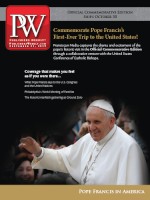With expanded programming time and new venues, New York Comic Con (NYCC) will take up four full days and a combined one million square feet in the Javits Center and Hammerstein Ballroom, the latter located a few blocks from the convention center. Though the ballroom was booked to feature more TV programming for NYCC, ReedPop, the show’s parent company, insists that the convention remains a comics publishing show at its core. NYCC will run October 8–11, in tandem with New York Super Week, a series of unofficial New York City pop culture events—reduced to about 100 this year—that begin the week before and lead into the opening of the show.
NYCC’s diverse programming schedule of comics, anime, film, TV, video games, and more will draw more than 150,000 badge holders to the Javits Center. And finally, after more than $2.4 billion and eight years of delays on the part of the MTA, visitors can take the 7 train to the show and disembark at 34th Street/Hudson Yards, an elegantly designed new subway station located directly across the street from Javits.
Unlike years past, NYCC’s Thursday programming is scheduled for a full day, a response to demands from fans, says Mike Kisken, v-p of ReedPop. Four-day badges and single-day badges for Friday, Saturday, and Sunday were sold out at the time of this writing, with a small number of the last remaining badges still available for purchase through comics retailer Midtown Comics in Manhattan. Though NYCC is working with a total of one million square feet, inside the Javits Center the organizer sought to find more space, especially for TV programming. On Friday and Saturday, NYCC badge holders can visit the nearby Hammerstein Ballroom for exclusive screenings from TV studios, including Cartoon Network, USA Network, and Starz. The ballroom has a capacity of 2,500.
“There was so much good content from studios that we just couldn’t fulfill all their needs,” says Mike Armstrong, event director of ReedPop’s North American events. “A lot of these relationships [with the studios] have been developing over the last five to seven years, as New York Comic Con has gotten more involved in the entertainment space.”
ReedPop’s decision to expand TV programming to the Hammerstein, rather than replace programming and content inside the Javits, perhaps explains why a number of comics creators are content with NYCC’s exhibition setup. More than 400 creators will set up in the Javits Center’s North Hall, a separate area with natural light that draws throngs of attendees looking to get autographs and buy comics and art. Many creators are happy using this setup for this year’s artist alley.
“Moving the artist alley to the separate hall means the people who go there are actually interested in art and comics,” says Gabriel Hardman, artist on Invisible Republic (Image). “It also takes away that expectation that everything will be a free sample, as with the media booths.”
Reilly Brown, currently drawing Marvel’s Mrs. Deadpool and the Howling Commandos, concurs that keeping artist alley in a separate area helps; people who come aren’t just standing in line to meet a celebrity but are interested in making purchases. “It’s a great way to meet fans and sell my work,” Brown says. “NYCC probably has the biggest and best artist alley of any convention I’ve ever been to.”
But independent artist Alitha E. Martinez notes that booth costs ($500 for a table) and logistics can be draining: “We’re not completely a part of the main show anymore. It’s like we’re not necessary. People who come back to the alley area are receptive, but I’m practically a field psychologist having to listen to all of the complaints about long lines, the overwhelming press of the crowded arena and all of its intense stimulation, and the high prices of autographed memorabilia from actors. It can be hard to redirect interest towards what’s on my table.”
Though ReedPop expanded the NYCC official programming for 2015, it decided to shrink the number of events that make up New York Super Week. NYSW director Matt Wasowski says that approximately 100 events are scheduled, down from the 157 events in its 2014 debut. “We just realized that we came almost too fast out of the gate last year. We think we actually just cannibalized some of our events,” he says. “This year we want to make sure the events get the attention they deserve.”
Wasowski also notes Super Week’s focus on comedy shows and podcasts. They’re more cost effective, he says, than concerts, and they work well in their “natural habitats,” such as theaters. “I really wanted to get more podcasts because they seem to be a popular entity at this point, and so few of them are done live.” Among those booked by Wasowski are Tracy Wilson and Holly Frey, the podcasters behind Stuff You Missed in History Class.
Despite ReedPop shrinking the number of New York Super Week events, the company still has plans for expansion on a more global scale. “We have some projects that we are working on here for the domestic side, but it’s probably nothing we can share at the moment,” Kisken says. “As we go through into the future, really the global market is where we’re headed, with some new shows that we launched in China this past year. There are some exciting things going on in the global market.”



 Volume 262
Issue 38
09/21/2015
Volume 262
Issue 38
09/21/2015





